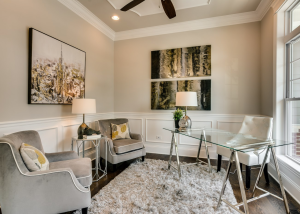About half of small and mid-sized businesses in Canada nowadays are being managed, whether part-time or full-time, from home. Evolving perceptions of work productivity and resourceful business processes are making it possible for more and more professionals to work remotely from home, thereby creating the need for a comfortable, functional home office space. In addition, employees and entrepreneurs who still go to a daytime workplace are also finding themselves bringing a lot of their work home, and they are also looking for a workspace at home where they can finish what they need to.

A house with a thoughtful and well-designed office space becomes memorable and more marketable to potential buyers who specifically want an organized area in the home for quietly working on tasks, so as you prepare your house for the market and plan your strategies with your home staging professional, you should pay close attention to the home office and staging it for selling success along with the rest of the home.
Some key points in staging your home office include:
-
- Put away personal stuff. Home staging is designed to help potential buyers imagine themselves living in your home, so your photographs, diplomas, and other personal mementos in your office should be packed up and stored. Personal files, documents, and mail are obviously sensitive material, and should not be in your home office (or lying around anywhere in the house, for that matter) during open house or showings.
-
- Clean, organize, and remove clutter. The desk and bookshelves in your home office can quickly accumulate papers, wrappers, bills, and other trash, so be sure to clean up what doesn’t need to be there. The shelves and desk, as well as other furniture in the area, should be clean and dirt-free; any small repairs should be accomplished, such as broken knobs or handles or wobbly table legs.
-
- Upgrade your furniture and fixtures. You can choose to purchase new furniture and take them with you when you move, or include the cost of the updates in the selling price. Either way, the furnishings in your home office should complement the overall theme of the rest of your house. If space is limited, do not overdo with too much or oversized desks or chairs; your home staging specialist would suggest that what you do have should be functional and aesthetic.
-
- Emphasize the significant details. Many professionals decide to work from home due to the flexibility and comfort of the arrangement, so as you work with your home staging professional make sure your home office area works with this perspective. Comfortable seating is a plus; if your home office area has a window view, maximize that by placing the desk or work area closer to the window, perhaps even facing it. Allow the right amount of natural light with the right window treatments.
- Storage and floor space are dealbreakers. Plan the office space so that people can move around comfortably and accomplish tasks without much difficulty. Bookshelves, cabinets, and drawers should be shown off because working from home usually means lots of stuff to file and compile. If the home office is in a smaller space, avoid area rugs or floor pillows as these make the floor area seem smaller.